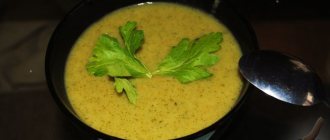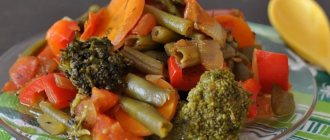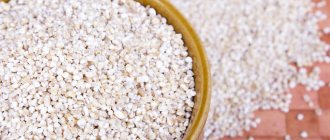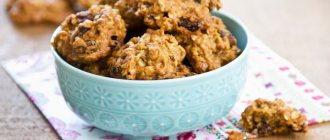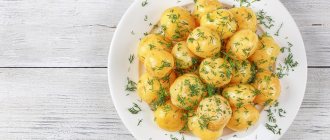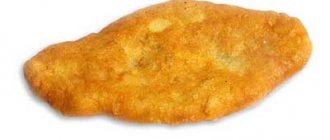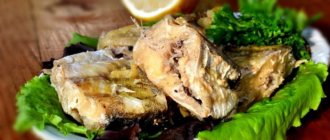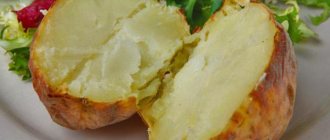Related Products
Sweet potatoes (91 cal) Jacket potatoes (82 cal) Boiled potatoes (84 cal) Red potatoes (70 cal) White potatoes (69 cal) Baked potatoes (93 cal) Roasted boiled potatoes (270 cal) ) Potato Hash Browns (213 cal) Fried Potatoes (168 cal) Raw Potatoes (74 cal) Whole Fried Potatoes (124 cal) Potato Skins (58 cal) Potato Flour (357 cal) Potato Stuff Pancakes (268 cal) Potato Salad (143 cal) Baked Potatoes (125 cal) Canned Potatoes (55 cal) Frozen Potatoes (77 cal) Potato Casserole (90 cal) Microwaved Potatoes (112 cal) .) Cooked Potatoes (79 cal)
Vitamins in Mashed Potatoes
Mashed potatoes contain the following vitamins: Mono- and disaccharides, Ash, Starch, Water, Organic acids, Dietary fiber, Unsaturated fatty acids, Sodium, Potassium, Phosphorus, Magnesium, Calcium, Sulfur, Copper, Boron, Aluminum, Strontium, Iodine, Manganese , Chromium, Fluorine, Molybdenum, Vanadium, Cobalt, Nickel, Rubidium, Selenium, Lithium, Tin, Zinc, Iron, Chlorine.
| Vitamin | Meaning |
| Vitamin B1 (thiamine), mg | 0,1 |
| Vitamin B2 (riboflavin), mg | 0,09 |
| Vitamin B6 (pyridoxine), mg | 0,3 |
| Vitamin B9 (folic), mcg | 8,2 |
| Vitamin C, mg | 14 |
| Vitamin E (TE), mg | 1,6 |
| Vitamin PP (Niacin equivalent), mg | 1,5482 |
| Vitamin B12 (cobalamins), mcg | 0,06 |
| Vitamin D, mcg | 0,008 |
| Vitamin A, mg | 0,05 |
| Choline, mg | 3,7 |
| Vitamin A (VE), mcg | 50 |
| Vitamin B5 (pantothenic), mg | 0,3 |
| Vitamin PP, mg | 1,1 |
| Vitamin H (biotin), mcg | 0,6 |
Composition of nutrients, BJU
Mashed potatoes
| For quantity: 100 grams | ||
| Calories — 106 | Calories from fat - 43 | |
| BJU | ||
| Total fat content | 4.83g | |
| Saturated | 2.87g | |
| Polyunsaturated | 0.33g | |
| Monounsaturated | 1.26g | |
| Cholesterol | 13mg | |
| Total carbohydrate content | 13.83g | |
| Dietary fiber | 1.6g | |
| Sugar | 1.6g | |
| Squirrels | 1.91g | |
| Vitamins and microelements | ||
| A - 45.25 µg | C - 5.45 mg | |
| B-6 – 0.11 mg | B-12 - 0.1 µg | |
| D - 0.15 µg | E - 0.18 mg | |
| Calcium 31mcg | Iron 0.22mg | |
| Magnesium 15.5 mg | Zinc 0.25mg | |
| Potassium 216 mg | Sodium 259 mg | |
Distribution of calories for BJU:Carbohydrates (52%) Fats (41%) Proteins (7%) | ||
Micro- and macroelements in mashed potatoes
Mashed potatoes contain the following elements: Mono- and disaccharides, Ash, Starch, Water, Organic acids, Dietary fiber, Unsaturated fatty acids, Sodium, Potassium, Phosphorus, Magnesium, Calcium, Sulfur, Copper, Boron, Aluminum, Strontium, Iodine, Manganese , Chromium, Fluorine, Molybdenum, Vanadium, Cobalt, Nickel, Rubidium, Selenium, Lithium, Tin, Zinc, Iron, Chlorine.
| Micro and macro element | Meaning |
| Mono- and disaccharides, g. | 1,7 |
| Zola, Mr. | 1,4 |
| Starch, Mr. | 11,1 |
| Water, city | 105,9 |
| Organic acids, g. | 0,2 |
| Dietary fiber, g. | 1,6 |
| Unsaturated fatty acids, g | 0,1 |
| Sodium, mg | 19,6 |
| Potassium, mg | 548,3 |
| Phosphorus, mg | 74,4 |
| Magnesium, mg | 24,1 |
| Calcium, mg | 28,3 |
| Sulfur, mg | 32,5 |
| Copper, µg | 125,2 |
| Boron, µg | 101,4 |
| Aluminum, µg | 765,5 |
| Strontium, mcg | 2,5 |
| Iodine, mcg | 5,7 |
| Manganese, mg | 0,1507 |
| Chromium, µg | 9,1 |
| Fluorine, mcg | 29,4 |
| Molybdenum, mcg | 7,8 |
| Vanadium, mcg | 131,3 |
| Cobalt, µg | 4,5 |
| Nickel, µg | 4,4 |
| Rubidium, mcg | 440,8 |
| Selenium, mcg | 0,3 |
| Lithium, mcg | 67,9 |
| Tin, µg | 1,9 |
| Zinc, mg | 0,3763 |
| Iron, mg | 0,9 |
| Chlorine, mg | 67,3 |
How to make puree with milk and butter?
Over its long history, even such a simple dish has acquired dozens, if not hundreds of different cooking methods. Below we present one of the recipes for this hearty dietary dish.
You will need:
- potatoes - 1 kg
- butter, 72% - 60g
- low-fat milk - 1.4 cups
Recipe:
- Wash and clean the tubers thoroughly, cut out the sprouts, if any. Potatoes of the same variety and approximately the same size are best boiled, so it is better to pre-cut especially large (compared to others) tubers into several pieces.
- Place them in boiling, well-salted water. Cook the potatoes for about 30 minutes over medium heat until tender. You can check the readiness of the tubers by piercing them with a fork - the core should be soft, pliable, and not crunchy.
- Drain the water (by the way, you can not just drain it, but use it for making homemade pastries and bread - due to the high starch content, such water will have a beneficial effect on the quality of the finished product). Mash the boiled tubers thoroughly with a spoon or masher until you obtain a homogeneous mass without lumps.
- Oil can be added at this stage, or you can wait until the dish is served - a matter of taste.
- Continue whisking slowly while gradually adding milk.
The puree is ready! When serving, it can be decorated with herbs. If you didn't add oil in step 4, don't forget to add it to the finished dish. Bon appetit!
Application in dietetics
Everyone's favorite is potatoes. It occupies a leading place among vegetables in terms of calorie content. Contains vitamins C, , and beta-carotene. Thanks to its rich composition, potatoes strengthen the walls of blood vessels, improve blood composition, strengthen tooth enamel and bone tissue, relieve swelling, stimulate the heart and brain, remove salt from the body, normalize metabolism and slow down the aging process.
Potatoes contain almost all the beneficial minerals, including phosphorus, sodium and potassium. The latter is simply necessary for people with diseases of the cardiovascular system. And it is thanks to potassium that potatoes are able to remove excess fluid from the body, which promotes weight loss.
The energy value of boiled jacket potatoes is not so high - 77 kcal/100 grams.
But we are used to eating potatoes or mashed potatoes with stewed meat, fried chicken or fish, all kinds of gravies and sauces. To avoid gaining weight, nutritionists advise serving fresh vegetable salads or sautes with potatoes. In combination with animal proteins and fats, potatoes do not contribute to weight loss, but exactly the opposite.
The same can be said with confidence about fried potatoes. If you want to lose weight, you will have to resolutely give it up. But mashed potatoes, despite being filling and tasty, are part of many weight loss diets. A proper diet based on mashed potatoes helps normalize metabolism, stomach function and weight loss.
If you want to get rid of extra pounds using a potato diet, you need to meet several conditions: do not eat mashed potatoes with meat or fish dishes . During the diet, forget about fatty sauces and fried foods. Nutritionists also advise excluding porridge and flour from your diet on the day you eat mashed potatoes.
Puree made from bags and plastic cups is not compatible with healthy eating and is not at all suitable for weight loss. Its calorie content is too high.
Remember that the daily carbohydrate requirement is provided by 300 grams of potatoes per day . Keep in mind that our body metabolizes carbohydrates only in the first half of the day, before 16:00. Then the rate of fat breakdown drops, and all the energy not spent before going to bed turns into adipose tissue.
Gravy for potatoes
Sauces for mashed potatoes can be prepared:
- from meat (veal, lean pork are more suitable);
- vegetables;
- mushrooms;
- based on sour cream, cream, tomato juice;
- with the addition of dry wine.
Beef gravy
To prepare meat gravy you need:
- 300 g beef (696 kcal);
- 1 medium carrot (75 g – 24 kcal);
- 2 onions (150 g – 62 kcal);
- salt to taste;
- 1-2 pinches of ground pepper (5 g – 13 kcal);
- 180 ml tomato juice (38 kcal);
- 2 tbsp. l. vegetable oil (306 kcal).
100 g of the finished dish contains about 153 kcal.
- First you need to cut the beef into small pieces (straws), remove the veins and rinse with running water.
- Next, the onions and carrots should be washed and peeled. It is recommended to cut the onion into half rings and grate the carrots on a coarse grater.
- Then place pieces of meat in a frying pan preheated with vegetable oil and fry over medium heat for 10 minutes.
- As soon as the meat begins to produce juice, add onions and carrots to the pan and fry for another 10 minutes.
- Next, add tomato juice to the contents, add salt and pepper. Simmer the goulash for 1 hour with the lid closed. If the beef is tough, the stewing time can be increased to 1.5 hours.
Depending on preference, the meat can be cut into large pieces. This will make it feel better.
Vegetable gravy
Vegetable sauce consists of:
- 2 onions (62 kcal);
- ½ part bell pepper (14 kcal);
- 1 medium sized carrot (24 kcal);
- 4 tbsp. l. tomato paste (111 kcal);
- 2 tbsp. l. flour (167 kcal);
- 1 tbsp. l. vegetable oil (153 kcal);
- 50-100 ml of boiled water;
- salt and black pepper 5-13 to taste.
Calorie content will be approximately 118 kcal per 100 g
- Vegetables must be washed first.
- You can grate the carrots on a coarse grater, chop the peppers and onions into small cubes.
- Place carrots and peppers in a heated frying pan with vegetable oil and fry for 2-3 minutes.
- Next, add onion, salt, pepper and mix thoroughly.
- Then you need to add flour, trying to distribute it evenly among the vegetables. All ingredients must be mixed thoroughly.
- Then add tomato paste to the mixture and mix again.
- Next you need to add water, salt and pepper the sauce if necessary and leave to simmer for 10 minutes.
Vegetable gravy can be served either cold or hot.
Mushroom sauce
Wild mushrooms or champignons can be taken as the main ingredient. Mushrooms should be pre-processed: peeled, cut into cubes, wild mushrooms should be additionally boiled.
The complete list of components is as follows:
- 400 g of mushrooms (108 kcal);
- 250 ml cream 20% fat (513 kcal);
- 1 tbsp. l. wheat flour (84 kcal);
- 1-2 medium onions (62 kcal per 150 g);
- 70 g butter (524 kcal);
- salt and pepper to taste.
This sauce is perishable, so it is not recommended to prepare it for future use. 100 g of sauce – 147 kcal.
- Mushrooms and onions should be finely chopped and placed in a frying pan heated with butter.
- The mixture must be fried for 7-10 minutes until the onion becomes transparent.
- Then, without removing the pan from the heat, sprinkle the already fried onions and mushrooms with flour, trying to distribute it as evenly as possible, and mix quickly.
- Then add cream, pouring in gradually with constant stirring.
- The gravy must be heated without letting it boil.
Forbidden delicacy or acceptable dish? Diet mashed potatoes
A slim body and a full stomach are real happiness for a woman. Just 10 years ago it was impossible to imagine how you could always stay in shape without limiting yourself to sweets and delicacies.
With the development of dietetics, which studies the principles of healthy and balanced nutrition, it has become possible to stay both full and happy without harming your figure. You just need to keep track of what ends up on your plate.
Basics of proper nutrition
In medicine, dietary nutrition means a special menu that includes only those products that contribute to the treatment and prevention of diseases. In addition, proper nutrition is practiced for aesthetic purposes - to reduce body weight.
Unlike strict diets, which involve constant malnutrition and strict restrictions, dietary nutrition does not harm the health of the person losing weight. A properly designed menu does not allow a sharp reduction in the number of calories, as this leads to a slowdown in metabolism and, as a consequence, to the deposition of excess fat.
Diet Basics:
- Maintaining the correct eating regimen. A follower of a healthy diet should eat at the allotted time, avoiding snacks. There should be at least 3 hours between meals.
- Chewing food thoroughly. The feeling of fullness occurs 30 minutes after the meal. If after eating the feeling of hunger does not subside, you just need to wait.
- Late meals should be avoided. If you go to bed by 11 o'clock, then your last meal should be taken no later than 7 pm. After this time, you can only allow one glass of kefir or a green apple.
- It is necessary to consume a large amount of liquid (water, juices, broths). This will create an imaginary feeling of satiety, and you will not have the desire to snack on junk food again.
- Once a week you need to have a fasting day.
Forbidden vegetable
Are potatoes bad for those trying to lose weight? Disagreements on this issue existed until recently, until it was proven that potatoes do not harm a healthy diet. If you do not add this vegetable to other foods containing large amounts of starch and carbohydrates, then its benefits are obvious.
Perhaps the only thing dangerous for your figure is fried potatoes. It absorbs a large amount of oil, which leads to a high calorie content of the dish.
100 g of fried potatoes can contain more than 210 kcal, with an average serving of 250 g this is a significant figure.
Therefore, you should not allow yourself such a delicacy more than once a month, but it is better to prepare healthy and dietary dishes for yourself every day.
Recipes
Below are a few basic recipes with photos of finished dishes. Based on them, you can then develop a large number of individual recipes. Diet mashed potatoes are very easy to prepare, so any housewife without cooking experience can master it.
Classic on the water
The calorie content of this mashed potato is 108 kcal per 100 g.
Ingredients:
- 1 kg potatoes (approximately 14 medium tubers);
- 1 chicken egg;
- 60 g butter;
- 2 bay leaves;
- black peppercorns;
- dill;
- salt.
Preparation:
- Peel the potatoes, carefully cut out all the eyes, and cut into medium-sized squares.
- Place the potatoes in a cooking pot and add water so that the water level covers the level of the potatoes.
- Bring water to a boil at maximum temperature, and after boiling, reduce.
- Add salt, pepper, bay leaf.
- Boil the potatoes until done.
- Carefully pour the resulting broth into a separate bowl.
- Mash the potatoes with a pestle or blender.
- Gradually add the egg and melted butter while continuing to mash the potatoes.
- Add potato broth in small portions, remembering to stir.
- The dish is ready. When serving, garnish with dill.
Interesting! If you remove butter from this recipe, the calorie content of the dish will drop to 82 kcal per 100 g.
In a slow cooker
The calorie content of mashed potatoes cooked according to this recipe is 60 kcal per 100 g.
Ingredients:
- 300 g potatoes (approximately 4 medium tubers);
- ½ glass of milk;
- 1 tsp. butter;
- salt.
Preparation:
- Wash the potatoes, peel them, carefully cut out all the eyes, cut into medium-sized squares.
- Place in a multicooker pan and add hot water until the water covers the potatoes. Add salt.
- Set the multicooker mode to “Steaming”, cooking time is 40 minutes.
- Bring the milk to a boil, but do not boil, add butter.
- After the multicooker signals that it is ready, remove the pan and drain all the liquid.
- Pour warm milk and butter into the potatoes. Grind into a puree as usual.
With onion, apple and caramel
The calorie content of mashed potatoes cooked according to this recipe is 140 kcal per 100 g.
Ingredients:
- all the ingredients of the classic recipe;
- 2 sour apples;
- 2 tbsp. l. lemon juice;
- 100 g onion;
- 1 tbsp. l. olive oil;
- 1 tbsp. l. Sahara;
- salt.
Preparation:
- Prepare classic mashed potatoes.
- Cut the apples into squares and add lemon juice.
- Cut the onion into thin rings.
- Mix the remaining butter with sugar and heat until the sugar is completely dissolved. Add salt.
- Add apples and caramelize for 2 minutes.
- Fry the onion in olive oil.
- Serve topped with caramelized apples and onions.
With shrimp and wasabi
The calorie content of mashed potatoes cooked according to this recipe is 140 kcal per 100 g.
Ingredients:
- all the ingredients of the classic recipe;
- 4 tsp. wasabi;
- 6 medium shrimp;
- 1 tbsp. l. olive oil (or any other vegetable oil);
- 1 clove of garlic;
- 3 sprigs of coriander;
- salt
Preparation:
- Prepare mashed potatoes according to the classic recipe.
- Add wasabi to the finished puree and mix thoroughly.
- Chop the shrimp.
- Heat the garlic in olive oil and fry the shrimp over low heat. Add salt.
- Serve the puree with the fried shrimp and coriander leaves.
With cauliflower
The calorie content of mashed potatoes cooked according to this recipe is 100 kcal per 100 g.
Ingredients:
- 600 g potatoes (approximately 10 medium tubers);
- 1 chicken egg;
- 60 g butter;
- 600 g cauliflower;
- green onions;
- salt.
Preparation:
- Peel the potatoes, carefully cut out all the eyes, and cut into medium-sized squares.
- Place the potatoes in a cooking pot and add water so that the water level is 1 cm above the potato level.
- Once boiling, add cauliflower florets.
- Cook until done.
- Drain off all the water. Add milk, butter, egg. Mash using a blender or other convenient method.
- Serve the puree with chopped green onions.
Tips and tricks
Mashed potatoes are a simple and tasty dish that anyone, even a novice housewife, can prepare. But there are still some cooking secrets that will make dietary mashed potatoes tender and airy.
Cooking secrets:
- To reduce the amount of starch in potatoes, root vegetables should be soaked in cold water overnight.
- Milk or cream must be preheated - this will make the dish more fluffy.
- Instead of milk or water, you can use chicken broth.
- If you add cold water to potatoes rather than boiling water, they will cook faster and have a more delicate taste.
- If the potatoes are old, you can add lemon juice to the water.
- To have fewer calories in the dish, mashed potatoes can be mixed with peas in a 1:1 ratio.
Useful properties of mashed potatoes
It is worth saying right away that puree is a fairly high-calorie dish, and its excessive consumption can lead to excess weight gain.
However, it is not for nothing that it is considered dietary - with a moderate approach, it will not only not harm, but will also show its beneficial properties, and there are many of them:
- contains a lot of fiber, which helps normalize the gastrointestinal tract and cleanse it of waste and toxins;
- vitamins and minerals help normalize and maintain the health of the body, skin, hair, nails;
- It has been proven that consuming puree helps strengthen the immune system and stable functioning of the nervous system, helps in the prevention of chronic fatigue;
- Due to its relatively low calorie content, puree is recommended to be added to the daily diet by many professional nutritionists.
Mashed potatoes, milk and butter are healthy and tasty products even individually, and their harmonious combination in one dish has reliably ensured its well-deserved place in the daily diet of so many families around the world.
Including it in your diet will provide you with an additional source of fiber, vitamins and minerals. As with any product in principle, the main thing is not to abuse it.
Three cooking methods
In the kitchen, the housewife must have all the necessary equipment with which she can make a dish of any complexity and consistency. To get the perfect mashed potatoes with calories ranging from 80 to 130 kcal, you can use three devices - each of them has its own advantages, and it’s up to you to decide which one you prefer.
- Mixer. Using this indispensable kitchen unit, you can prepare puree from any product. Place the hot boiled potatoes in a bowl and add the egg, butter, milk and spices. In just a few minutes you will have a great side dish ready. The calorie content of mashed potatoes prepared in this way will be 132 kcal.
- Sieve. Pureed foods are great for children and the elderly. True, you won’t be able to pass an egg with butter through a sieve, but the mashed potatoes will be more dietary - only 80 kcal per 100 grams.
- Wooden crusher. With its help you can prepare puree of any homogeneity. This method is much faster than rubbing through a sieve.
How many calories are in potatoes (mashed, boiled, fried) per 100 grams?
Potato dishes are rich in flavor and nutritious
During a diet, it is important to choose the least calorie ones. Depending on the method of preparing the vegetable, the energy value also changes.
Nutritional value of potatoes
Potato tubers are a source of not only complex carbohydrates, but also various microelements, as well as dietary fiber. Due to its fiber content, the vegetable is useful for disorders of the digestive tract. Potassium helps to quickly remove excess fluid and normalize heart function.
70 kcal, and in 100 g -
76 kcal) is due to the significant content of carbohydrates, mainly starch.
In terms of their quantity, the vegetable exceeds all others, for example, beets and carrots. See the vegetable calorie table. The share of starch, the concentration of which is highest in the tubers of the autumn harvest, accounts for over 20% of the total weight of the root crop. That is why the young vegetable does not have such a high energy value - about 60 kcal. During heat treatment, calorie content increases significantly.
Calorie content of mashed potatoes
The calorie content of mashed potatoes can be low if milk with 0% fat or water is added during the process. One 100-gram serving contains about 85 kcal. If you choose fattier milk, the indicator can increase to 35 units. Any oil significantly increases the nutritional value of a dish.
You can reduce the energy value if you cook your favorite dish in dishes coated with ceramic, marble or Teflon.
In addition, it is important to ensure that no more than 10 g of fat-containing product is consumed per 500 g of root vegetables. Read about the nutritional composition (BJU) of potatoes in our article
How many calories are in boiled, fried, baked potatoes?
The dietary option for preparing vegetables includes boiling them (about 85 kcal). In terms of energy value, boiled potatoes are inferior to pasta, wheat bread, bananas and buckwheat. Read about the calorie content of buckwheat here. However, this only applies to cases where mayonnaise, cream sauce or butter is not added.
The calorie content of baked potatoes is identical to that of boiled potatoes, but any additive increases these numbers. You can reduce the starch content by leaving the vegetable in cool water for several hours. Fried potatoes contain 3 times more calories (up to 200 kcal).
The type of oil has a slight effect on the energy value: when cooking with olive, sunflower or butter, the numbers will be approximately the same. More information about the calorie content of vegetable oil can be found in our publication. French fries contain about 310 kcal, and in fast food restaurants, a serving of deep-fried vegetable will cost almost 280 kcal.
Potato calorie table per 100 grams
You can get acquainted with the energy value of a popular vegetable using the table of calorie content per 100 g.
Calorie content of potato dishes
Most dishes with the popular root vegetable can hardly be called dietary, so people trying to get rid of extra pounds should refrain from eating them.
Options for first, second courses and baked goods with potatoes:
- noodle soup – 69 kcal;
- chicken broth soup – 50 kcal;
- dumplings – 220 kcal;
- chicken stew – 150 kcal;
- country-style potatoes – 130 kcal;
- fried pies – 200 kcal;
- potato pancakes – 220 kcal;
- casserole with mushrooms – 170 kcal;
- homemade chips – 500 kcal;
- stewed potatoes with cabbage and onions – 95 kcal.
To satisfy the body's needs for such important substances and elements as phosphorus, potassium, carbohydrates, you need to eat about 300 g of vegetables per day. A larger amount will increase your waist by several centimeters.
When choosing the least high-calorie dishes, you don’t have to worry about gaining extra pounds. A starchy vegetable consumed in moderation will only benefit the body.
Nuances in preparing mashed potatoes
Mashed potatoes are a tasty, satisfying, not too high-calorie dish. The calorie content of a simple puree with water is noticeably different from the calorie content of a dish with milk and butter; for a specific diet, it is important to know which type of puree is best suited and how to calculate the effect on the body’s daily energy balance.
Potatoes are healthy, but there are several nuances in preparation:
- It is better to eat boiled, steamed or baked, since its calorie content increases when frying and deep-frying.
- You should not cook potatoes with meat and overuse sauces - instead of mayonnaise or ketchup, it is better to season the finished potato dish with, for example, lemon juice or sour cream.
- Potatoes contain a large amount of starch, which is quickly metabolized into sugar, and are usually contraindicated for diabetics, although one serving per week is often allowed.
Nutritional value and calorie content of mashed potatoes
If we talk about the nutritional value of the product, then a serving weighing 100 g contains approximately 3% protein and 5% fat and carbohydrates of the daily requirement.
This is not much higher than the nutritional value of boiled potatoes, so those who believe that eating this dish tends to interfere with weight loss are mistaken.
Recommended reading: Benefits of boiled beets for the body
If 100 g of crushed potatoes have a calorie content of about 90 kcal, then depending on the method of preparing the dish, this figure, of course, changes. For example, when adding milk it increases to 110 kcal, but butter adds only 10 kcal.

